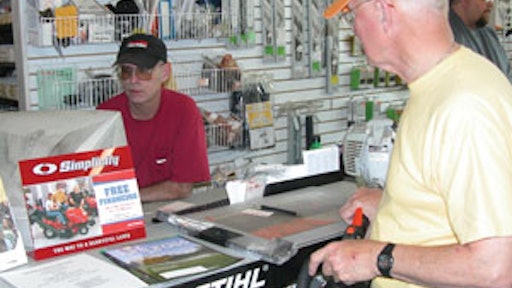
For dealers, a part of their business that has proven profitable—yet at the same time difficult to perfect—is the service department. There are many basic principles to follow in order to run a service department that delivers the utmost in customer satisfaction. The underlying similarity in these principles is effective communication.
Having skilled technicians and good, quality systems are essential to having a successful and profitable service department. Providing satisfactory service that brings customers back is vital to success as the returning customer is where the money lies. Whether it is the signage or employees doing the communicating, when done successfully it can mean the difference between a satisfied and discontented customer.
SURROUNDINGS THAT GUIDE AND SOOTHE
The moment a customer first walks into a dealership is when their service experience begins. This is why the layout of the dealership and service department are essential. The surroundings and layout should communicate to customers what they need to do next when entering the facility.
“When you walk into some dealerships, you can’t even find the shop,” explains service trainer Ed Kovalchick of Net Profit Inc. in Alabaster, AL. “To begin with, the service department needs to be well-marked. You should have directional and informational signs telling the customers where to go and what to do when they get there.” The customer’s experience with the service department will not start out well if they are confused as soon as they enter the dealership doors, unsure of where to go. Keeping the reception and service areas clearly labeled is essential.
Near the service area or reception counter, any technician certification should be proudly displayed. Posted certificates will put customers at ease when dropping off equipment, communicating to them the high skill level of the technicians working on their equipment. “Customers want security in knowing that their equipment is going to be fixed correctly,” shares Jim Roche, EETC executive director. “One thing that gives that to the customer is having all of the technician certifications from manufacturers and the EETC posted wherever work orders are written up.” Posting certification in plain view or speaking with customers about certification offers them a sense of security that their product is going to be repaired properly the first time.
INTERACTION WITH STAFF
The person working the service counter and speaking with the customers is just as important as the certificates that surround it. Customers should be greeted by a professional and knowledgeable individual who they feel comfortable handing their equipment over to. The person writing up the order should also have an impressive amount of product knowledge and the ability to clearly communicate and discuss that knowledge with the customer.
“Customers are paying for knowledge, so there should be a demonstration of some,” says Kovalchick. “When they drop off their equipment and ask questions, they should get them answered well or they will lose confidence.” If a customer trusts the knowledge of employees in the service department, it will further guarantee retention of that customer.
The ability to listen is a vital part of being an effective communicator. Along with product knowledge, the service department staff should show they care about the customer’s equipment by listening carefully to the issue they are having with the product. “The customer should be greeted by someone who is compassionate about his or her product,” advises Roche. “When the dealership shows a connection with the customer on a problem, the customer is going to feel really good about choosing that dealer.”
KNOWING THE NEEDS OF THE CUSTOMER
By showing compassion for the customer’s equipment and listening carefully, you can learn a lot about the customer and their needs. Some basic guidelines for satisfying customer needs include fixing their equipment quickly and correctly the first time, and returning it to them in clean condition. Going beyond the basics of satisfaction is possible when you know the customer’s specific needs. Conversing extensively with the customer is a great way to learn what their specific needs are.
“We know most of our customers personally, so we try to give employees some background on what the customer is using the equipment for and what the customer expects from the equipment,” shares Mark Saulter of Saulco Enterprises, a dealership in Bracebridge, Ontario. “Many of our employees get to know the customer on a personal level as well. This personalized service, an age old successful business approach, is sadly lacking in our mass merchant, disposable society.”
This personalized and attentive service is something customers won’t find when doing business with a big box store. Their relationship with the business usually ends once the product or equipment is paid for. Saulter, like many outdoor power equipment dealers, chooses to take a different approach.
“We offer the customer a partnership for the life of their equipment,” explains Saulter. “Our approach is the opposite of the box stores who have an impersonal, one-time relationship with the customer based solely on a business transaction.”
CONSUMER AND COMMERCIAL NEEDS
Listening to and getting to know a customer on an individual basis is a great way to learn their individual needs and desires. When dealing with commercial and consumer customers, some of what they need from the service department varies significantly.
“We try to treat both our consumer and commercial customers the same,” says Jeff Deen of the Deen Implement Co. in Forney, TX. “In each of their minds, their needs are the most important so we try to make them all feel important.” Dealers should express to each customer that they are a priority.
Satisfying both the consumer and commercial customer in the service department can be a difficult task. Deen agrees that communicating with and knowing them as individuals better assures satisfaction. “The best solution is to try and understand and know each of your customers individually. Then it will be easier to try and meet their individual expectations.”
Once a clear understanding of the customer’s
expectations has been established, communicate to them how you will meet their needs and
desires.
Continuous and open communication
Keeping the lines of communication clear and open, throughout the service experience, shows the commercial and consumer customers their worth. Clearly and accurately explaining services and billing initially and throughout the process prevents surprising and possibly upsetting the customer.
“Explain to the customer what they are paying for, what you did, why you did it and what it cost,” urges Kovalchick. “People want to know what they are paying for.” Be sure to also discuss billing and service details when equipment is delivered or picked up so customers aren’t confronted with a confusing repair invoice.
“Communication is key,” agrees Saulter, who continuously communicates with customers about the health of their equipment. “When performing repairs, we advise the customer on the problems found and what options are available for correcting the problem. If any additional maintenance items are noted, we will review these with the customer as well.”
At each visit, Saulter keeps the customers informed on items that are starting to wear but do not yet require immediate replacement. This helps the customer to plan for future maintenance requirements. By communicating throughout the whole process, the customer feels as though they are a part of the solution.
URGENT REPAIR
When the communication is lacking or the service disappoints, you may end up with a very unhappy customer who will hit back with two blows: They will not return to your shop for service, and will tell all their friends to do the same. An angry customer can be really damaging to the success of the service department. This is why repairing those relationships is vital. “It is important to never hesitate to correct something that has been done wrong,” says Deen. “Always seem willing to help and understand the issue completely.”
Dealing with the customer’s dissatisfaction can be done in many ways. How quickly and how well it is handled may lead to a mended relationship that is better than it was initially. “If you make a mistake, it can help you to have a better relationship with your customer than prior to the mistake,” says Kovalchick. “That is something that every employee needs to understand and be told. A mistake is not a bad thing unless it is not corrected properly.” By addressing the dissatisfaction in an urgent manner, it communicates to the customer just how much you care about their happiness.
One way to find out where customer dissatisfaction comes from is by evaluating you Customer Satisfaction Index (CSI). This can be done by calling customers after they have received service, asking them to fill out a survey during equipment pickup or by simply listening to their concerns.
Obtaining information about how satisfied or dissatisfied your customers are is only the first part; dealers need to communicate these findings to their staff. “The result is as important as we make it,” says Kovalchick. “If we never bring it up and never talk to the employees about taking care of customers and don’t measure whether we took care of the customer, why should they care?” Once management puts an emphasis on customer satisfaction and communicates its importance to their staff, they will actively share a common goal.
As dealers and technicians continue to use effective verbal and non-verbal communication in the service department, they will have a better chance of ensuring a satisfactory experience for customers. By keeping the lines of communication open and listening to customers’ needs and concerns, dealers and techs will form a relationship with customers built off satisfactory experiences.




























